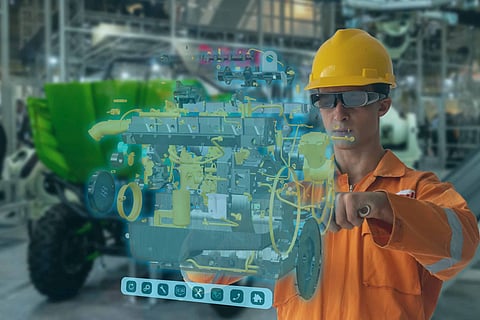
- Insights
- Cryptocurrencies
- Stocks
- White Papers
- Industry
- Geography
- Insights
- Cryptocurrencies
- Stocks
- White Papers
- Industry
- Geography


The world is truly shaped by many advancements in digital technology. There's no stopping its improvement, given that technology is constantly improving by the day. One of the facets of business that's positively affected by these improvements is the manufacturing industry. From manual and more primitive processes in the past to automated and advanced processes today, production and manufacturing is evidently now more efficient than it ever has been.
One of the key players in these positive changes is artificial intelligence, or AI, for short. As a quick background, artificial intelligence refers to the simulation of human intelligence in machines. These machines are programmed to mimic the mind and actions of human beings. When it comes to production and manufacturing, these are those machines used that are associated with the problem-solving and learning capacities of the human mind.
While these are big changes to key in, the effects are also tremendous. To make you understand its effects further, here's an insight on how AI is transforming production and manufacturing:
In manufacturing, there's such a thing as digital twins. This refers to a virtual, but exact reproduction of a real asset or product, such as immediately creating copies of different types of FIBC bags. With this, manufacturers can now have an in-depth understanding of these products and give businesses enough leeway to experiment with future products. That way, asset performance is enhanced.
Applying digital twin technology in the production and manufacturing line of business results in many businesses, including:
One of the inherent challenges of the production line has to do with demand forecasting and planning. It's very important to achieve this accurately so that the company doesn't produce too little (or too much) supply at any given period. Producing too little will break customer satisfaction when demands aren't met, while too much may result in surplus and, therefore, wastage.
Through AI, production and manufacturing teams can now make use of machine learning. With it, they're able to detect data patterns and automate analysis in a way that's impossible for human employees to do on their own.
Then, moving even further, these data patterns can be further segmented, such that a more accurate demand forecasting and planning is achieved. This is very important for businesses to achieve, as it results in the following advantages:
There are instances in the manufacturing and production line when engineers will have to start with product development from scratch. This means that after receiving the specifications of each client's orders, the engineers will create a design.
In the past, these design options are submitted manually to the clients, where they go through these and make their revisions. It can be labor-intensive and time-consuming when these revisions come in, simply because the variety of design options was very limited. Had there been other options, clients will have more to go through, possibly reducing the need for constant revisions.
At present, with the use of AI, engineers can immediately create thousands of design options to present to clients quickly. This is enabled through generative design which utilizes machine learning algorithms to mirror an engineer's design approach. This would include factoring in certain metrics like cost constraints, size, manufacturing methods, and weight. That way, all the design product options can be created within those parameters.
A manufacturing plant can't function correctly if its equipment isn't efficient anymore. Hence there's a need to keep these well-maintained all the time.
Many years back, the maintenance and development of manufacturing machines and equipment was a manual process. This would result in a high margin of human error. Plus, it also heightens the risk of equipment malfunctions. Like a domino effect, productivity is decreased, and the production schedule is also significantly affected.
With preventive maintenance because of the presence of artificial intelligence, this down time is reduced. Manufacturers have a better means of creating an asset viability plan that gives indicators as to when it's most likely time to upgrade or resolve minor issues. As soon as these problems occur, the solutions are then implemented right away.
Because equipment is now more efficiently maintained and kept, product development and optimization of the production line are improved.
With all these benefits, it's easy to see now that artificial intelligence and manufacturing or production go hand-in-hand. These two are, without a doubt, a perfect match for each other. Manufacturing is a very important aspect of product development, and you need the proper analytical data for these machines to analyze properly. To create a more efficient and productive flow of work in your machine line, it's worth considering switching to artificial intelligence capabilities for this year, moving forward.
